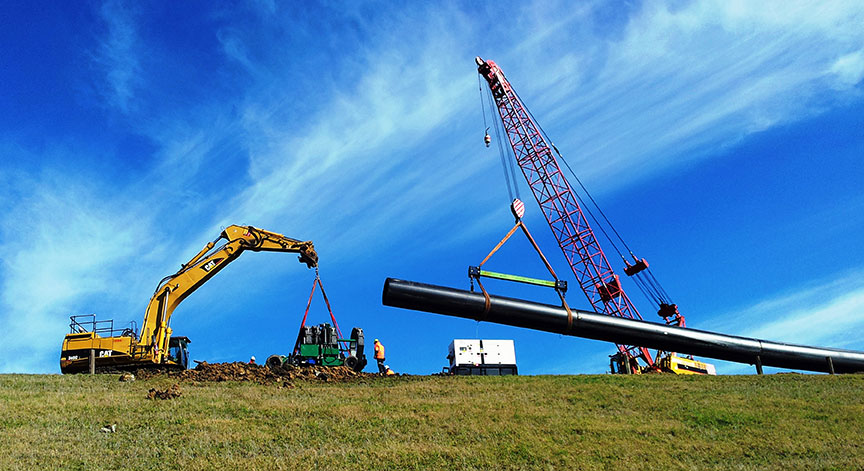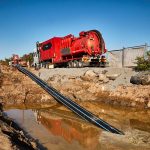An Introduction to the Next Generation PE Pipe Grade Resin

Over the last 70 years, plastic piping materials have transformed civil engineering practices. Compared to traditional materials such as concrete, clay, steel or ductile iron, plastic pipes are faster to install, have lower failure rates, and last longer. Polyethylene (PE) has emerged as the material of choice for gas distribution, mining, and large diameter water pipes, especially when combined with trenchless pipe installation. This wide adoption is due to PE piping’s flexibility, resistance to corrosion, welded joints that are as robust as the pipe itself, and excellent resistance to slow crack growth (scg).
Evolution
Evolution of the material’s properties has played a central role in the continued success of polyethylene pipe systems. The first PE pipes, also known as a polypipe, used in Australia in the 1950’s were based on HDPE Type 50. These early pipes were used for irrigation and mining, and in the 1960’s for gas distribution. The “50” designates a minimum required strength (MRS) of 5 MPa. This rating is an indication of the material’s resistance to internal pressure when it is extruded into a pipe with a minimum design life of 50 years at 20°C. PE80 compounds were introduced in the 1980s. With an MRS of 8 MPa, the maximum operating pressure (MAOP) rating of the pipes was raised. In the 1990s, PE100 was developed with an MRS of 10 MPa and an MAOP of 2500 kPa for water applications and 1000 kPa for gas use.
These more advanced materials not only provided pipes with higher pressure ratings but also enabled a reduction in the wall thickness for lower pressure rated pipes, so the PE100 pipe dimensions improve the overall cost efficiency of the network. The ratio between wall thickness and pipe diameter is defined as the standard dimension ratio (SDR). The SDR has been standardised to ensure compatibility between piping components. The higher the SDR, the lower the relative wall thickness of the pipe.
Slow Crack Growth
It’s important to note that every increase in a material’s resistance to internal pressure must be accompanied by an increase in the resistance against other potential modes of failure. Apart from third party damage, the most commonly observed mode of pipe failure in the field is “brittle” failure due to SCG. Review of the pipe failure statistics in Australia for early generation pipe resins e.g. in gas distribution, shows a failure rate of approximately 200 to 300 per annum. The highest percentage failure in 1983 was due to point loading (64%), whereas the highest percentage in 1986 was due to mechanical damage (66%). Mechanical damage and point loading accounted for the vast majority of identified PE pipe failures over the period. As the stress in the pipe wall increases with pressure, the pipe becomes more sensitive to crack initiation and growth. Consequently, PE100 pipes must pass more stringent specifications for SCG; for example at least 500 hours in the notched pipe test at 920 kPa compared to PE80, which is tested at 800 kPa, highlighting a big difference between PE80 and PE100.

Figure 1. Evolution of PE pressure pipe resins with respect to minimum required strength (MRS), slow crack growth (SCG), and rapid crack propagation (RCP). Relative scales have been applied.
Rapid Crack Propagation
Another mode of failure that must always be considered during PE resin development is rapid crack propagation (RCP). RCP is of concern in applications where high internal gas pressure is combined with low application temperature, and so this additional requirement was introduced when PE100 was developed.
Another important factor in PE resin development is its resistance against long term oxidative degradation. Sophisticated stabilisation packages have been developed for the latest generation PE100 materials that offer protection for over 100 years, under normal service conditions. When temperatures exceed 20°C and/or pipes are used to transport water containing high concentrations of chlorine-based disinfectants, oxidation is accelerated and pipe-lifetime is reduced.
Higher Standards
A key aspect in the development and market acceptance of polyethylene pipes is that standards keep pace with advancements in material performance. Quality Product performance standards link the requirements for the material, pipes, fittings, valves and fitness for purpose, i.e. testing of the jointed components of the system. Before engineers can apply design factors based on new materials, the implications of the new material developments must be considered in the context of the piping system as a whole. The framework of international standards ISO 4437/4427, Australian and New Zealand AS/NZS 4131/4130 standards, in combination with National Codes such as the Water Services Association of Australia (WSAA) design standard polyethylene pipeline code, or the Coal Seam Gas industry code of practice (CoP), underpins the integrity of current and future pipeline networks.
Nearly 30 years after its initial introduction to the market, most PE piping systems are manufactured using PE100 specification or its analogue PE4710 in North America.
So,“what’s next?” The next instalment of this series will provide an overview of the new developments within the PE100 class of compounds and will discuss the potential benefits of the next generation of PE pipe materials.
Until then, why not dig in to some of our case Studies




